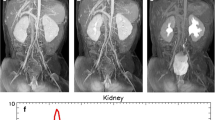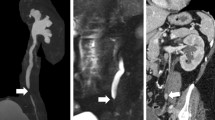Abstract
Background
Recent studies have demonstrated magnetic resonance (MR) capabilities in evaluating renal morphology and function in patients with urinary obstruction. The objective of this report is to support the introduction of dynamic MR renography on any MR equipment.
Methods
A custom-made device of vials filled with different concentrations of gadolinium was studied by combinations of T1-weighted gradient-echo sequences and coils. We compared the capabilities of two coils (phased array vs. standard body), the properties of dynamic sequences, and the effects of increasing concentrations of gadolinium on signal intensity. In a second section, we designed MR urography plug-ins of Image J (DICOM image software) for the analysis of dynamic studies.
Results
Optimized gradient-echo sequences acquired with a phased array body coil produced acceptable quality images with a linear relation between signal intensity and the lowest concentrations of gadolinium. In vitro measurements showed loss of linearity above 8 mmol/L.
Conclusion
Theoretical calculation and data from the literature suggest that the gadolinium dose to the patient should not exceed one-fourth of the usual one (0.025 mmol/kg). Postprocessing using Image J software and the specifically designed plug-ins was validated. The collection of plug-ins is now available on the Internet.







Similar content being viewed by others
References
Nolte-Ernsting CC, Staatz G, Tacke J, Gunther RW (2003) MR urography today. Abdom Imaging 28:191–209
Borthne A, Nordshus T, Reiseter T, et al. (1999) MR urography: the future gold standard in paediatric urogenital imaging? Pediatr Radiol 29:694–701
Rohrschneider WK, Haufe S, Wiesel M, et al. (2002) Functional and morphologic evaluation of congenital urinary combined static-dynamic MR urography: findings in kidneys with a single collecting system. Radiology 224:683–694
Rothpearl A, Frager D, Subramanian A, et al. (1995) MR urography: technique and application. Radiology 194:125–130
Aerts P, Van Hoe L, Bosmans H, et al. (1996) Breath-Hold MR urography using the HASTE technique. AJR 166:543–545
Teh HS, Ang ES, Wong WC, et al. (2003) MR renography using a dynamic gradient-echo sequence and low-dose gadopentetate dimeglumine as an alternative to radionuclide renography. AJR 181:441–450
O’Reilly P, Aurell M, Britton K, et al. (1996) Consensus on diuresis renography for investigating the dilated upper urinary tract. Radionuclides in Nephrourology Group. Consensus Committee on Diuresis Renography. J Nucl Med 37:1872–1876
Escott EJ, Rubinstein D (2003) Free DICOM image viewing and processing software for your desktop computer: what’s available and what it can do for you. Radiographics 23:1341–1357
Rohrschneider WK, Haufe S, Clorius JH, Tröger J (2003) MR to assess renal function in children. Eur Radiol 13:1033–1045
Rohrschneider WK, Hoffend J, Becker K, et al. (2000) Combined static-dynamic MR urography for the simultaneous evaluation of morphology and function in urinary tract obstruction. Evaluation of the normal status in an animal model. Pediatr Radiol 30:511–522
Rohrschneider WK, Hoffend J, Becker K, et al. (2000) Combined static-dynamic MR urography for the simultaneous evaluation of morphology and function in urinary tract obstruction. Findings in experimentally induced ureteric stenosis. Pediatr Radiol 30:523–532
Nolte-Ernsting CC, Adam GB, Gunther RW (2001) MR urography: examination techniques and clinical applications. Eur Radiol 11:355–372
Tang Y, Yamashita Y, Namimoto T, et al. (1996) The value of MR urography that uses HASTE sequences to reveal urinary tract disorders. AJR 167:1497–1502
Taylor J, Summers PE, Keevil SF, et al. (1997) Magnetic resonance renography: optimization of pulse sequence parameters and Gd-DTPA dose, and comparison with radionuclide renography. Magn Reson Imaging 15:637–649
Grattan-Smith JD, Perez-Bayfield MR, Jones RA, et al. (2003) MR imaging of kidneys: functional evaluation using F-15 perfusion imaging. Pediatr Radiol 33:293–304
Grenier N, Basseau F, Ries M, et al. (2003) Functional MRI of the kidney. Abdom Imaging 28:164–175
Lee VS, Rusinek H, Lee P, et al. (2003) Dynamic three-dimensional MR renography of single kidney function: initial experience. Radiology 227:289–294
Semelka RC, Hricak H, Tomei E, et al. (1990) Obstructive nephropathy: evaluation with dynamic Gd-DTPA-enhanced MR imaging. Radiology 175:797–803
Knesplova L, Krestin GP (1998) Magnetic resonance in the assessment of renal function. Eur Radiol 8:201–211
Krestin GP, Schuhmann-Giampieri G, Haustein J, et al. (1992) Functional dynamic MRI, pharmacokinetics and safety of Gd-DTPA in patients with impaired renal function. Eur Radiol 2:16–32
Kastler B, Vetter D, Patay Z, Germain P. Imagerie rapide. In: Kastler B, ed. Comprendre l’IRM: Manuel d’auto apprentissage. Paris: Masson, 2003:133–175
Kikinis R, Von Schulthess GK, Jäger P, et al. (1987) Normal and hydronephrotic kidney: Evaluation of renal function with contrast-enhanced MR imaging. Radiology 165:837–842
Hittmair K, Turetschek K, Gomiscek G, et al. (1996) Field strength dependence of MRI contrast enhancement: phantom measurements and application to dynamic breast imaging. Br J Radiol 69:215–220
Katzberg RW, Ivanovic M, Buonocore MH, et al. (2002) Gadolinium-enhanced T1-weighted renal and abdominal imaging: quantitative discrepancy between clinical and in vitro findings. Acad Radiol 9:679–687
Strich G, Hagan PL, Gerber KH, Slutsky RA (1985) Tissue distribution and magnetic resonance spin lattice relaxation effects of gadolinium-DTPA. Radiology 154:723–726
Jones RA, Perez-Brayfield MR, Kirsch A, Grattan Smith JD (2004) Renal transit time with MR urography in children. Radiology 233:41–50
Bakker J, Olree M, Kaatee R, et al. (1999) Renal volume measurements: accuracy and repeatability of US compared with that of MR imaging. Radiology 211:623–62
Acknowledgments
This study was supported by a research grant from Rouen University Hospital (2000/105HP). Schering France provided the contrast medium (Magnevist) that was been used in phantom and clinical studies. The authors thank Philippe Le Hué, Eric Dumont, Denis Thoumas, and Lionel Nicol for assistance in performing the phantom study and preliminary clinical studies and Sylvain Payrouse, Sonia Choubrac, and Mickael Dolores for help in writing the plug-in software.
Author information
Authors and Affiliations
Corresponding author
Rights and permissions
About this article
Cite this article
Lefort, C., Marouteau-Pasquier, N., Pesquet, AS. et al. Dynamic MR urography in urinary tract obstruction: implementation and preliminary results. Abdom Imaging 31, 232–240 (2006). https://doi.org/10.1007/s00261-005-0391-8
Published:
Issue Date:
DOI: https://doi.org/10.1007/s00261-005-0391-8




